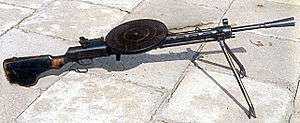Degtyaryov machine gun
The Degtyaryov machine gun (Russian: Пулемёт Дегтярёвa Пехотный Pulemyot Degtyaryova Pekhotny "Degtyaryov's infantry machine gun") or DP-27 is a light machine gun firing the 7.62×54mmR cartridge that was primarily used by the Soviet Union, with service trials starting in 1927 followed by general deployment in 1928. Besides being the standard Soviet infantry light machine gun (LMG) during WWII, with various modifications it was used in aircraft as a flexible defensive weapon, and it equipped almost all Soviet tanks in WWII as either a flexible bow machine gun or a co-axial machine gun controlled by the gunner. It was improved in 1943 producing the DPM, but it was replaced in 1946 with the RP-46 which improved on the basic DP design by converting it to use belt feed. The DP machine gun was supplemented in the 1950s by the more modern RPD machine gun and entirely replaced in Soviet service by the general purpose PK machine gun in the 1960s.
| DP Machine Gun | |
|---|---|
 DP-27 | |
| Type | Light machine gun |
| Place of origin | Soviet Union |
| Service history | |
| In service | 1928–1960s (USSR) |
| Used by | See Users |
| Wars | Spanish Civil War Winter War World War II Second Sino-Japanese War Korean War Chinese Civil War First Indochina War Vietnam War Hungarian Revolution of 1956[1] Laotian Civil War North Yemen Civil War[2] Cambodian Civil War Cambodian-Vietnamese War Rhodesian Bush War Afghan Wars Sino-Vietnamese War Sri Lankan Civil War Nagorno Karabakh War[3] Georgian Civil War[4] Bangladesh Liberation War[5] Yugoslav Wars Somali Civil War Iraq War 2011 Libyan Civil War Northern Mali conflict Syrian Civil War[6] War in Donbass |
| Production history | |
| Designer | Vasily Degtyaryov |
| Designed | 1927 |
| Produced | 1928–1950s (USSR) |
| No. built | 795,000 [7] (all variants) |
| Variants | DP DPT DPM DPA DTM-4 RP-46 Type 53 |
| Specifications | |
| Mass | 9.12 kg (20.11 lb) (unloaded) 11.5 kg (25 lb) (loaded) |
| Length | DP, DPM – 1,270 mm (50.0 in) RP-46 – 1,272 mm (50.1 in) |
| Barrel length | DP, DPM – 604 mm (23.8 in) RP-46 – 605 mm (23.8 in) |
| Cartridge | 7.62×54mmR |
| Caliber | 7.62 mm |
| Action | Gas-Operated, flapper locking |
| Rate of fire | 550 rpm |
| Muzzle velocity | 840 m/s (2,755 ft/s) |
| Effective firing range | 800 m (874.9 yd) |
| Feed system | 47-round pan 63-round pan (DT & DTM) belt feed (RP-46) 30-round overhead box magazine (PD-36 and DTM-4) |
| Sights | Adjustable iron sights, front post and rear notch on a scaled tangent |
Design
The DP-27 was a light machine gun designed for the Soviet Red Army in the 1920s under the leadership of Vasily Degtyarev (1880-1949), the first test model being the DP-26. Two test guns were manufactured and fired 5,000 rounds each from September 27 -29, 1926, during which weaknesses were discovered in the extractor and firing pin mechanisms. After design improvements, two more guns were made and tested in December of 1926, firing 40,000 rounds under adverse conditions, resulting in only .6% stoppages. However, changes to the bolt carrier and the chamber locking mechanism were still required. After this redesign the improved gun, now called the DP-27, was tested by the Red Army at the Kovrov plant on January 17-21 of 1927, passing all tests and being approved for manufacture. A full year of service testing followed, after which the primary requested change was the addition of the large flash suppressor that is now considered one of the recognition features of the design.[8] With further refinements, the DP was to be the primary light machine gun of the Red Army during WWII.
As with most other light machine guns of WWII, the DP-27 was designed to fire the same 7.62×54mmR (R indicating Rimmed) ammunition as the main Soviet infantry battle rifle, the Mosin-Nagant, much simplifying ammunition logistics for Soviet infantry units. Of typical Russian design philosophy, the DP-27 was a sturdy and simple gun that was easy and cheap to manufacture, and could be relied upon to perform even in the most adverse conditions; it was capable of withstanding being buried in dirt, mud, or sand and still operating consistently. However it had a low rate of fire when compared to its main wartime rival, the German MG 34/MG 42 series, firing at a rate of 550rpm as compared to the 800-1200rpm of the German light machine guns.
The operating mechanism of the DP-27 was gas-operated, using a Kjellmann-Friberg flap locking design to lock the bolt against the chamber until the round had left the barrel, aided by a recoil spring.[9] Ammunition came in the form of a 47-round circular pan magazine that attached to the top of the receiver. It was this disc-shaped, rotating magazine that led Soviet soldiers to call the DP, in typical soldier slang, the "record player".
Its main parts were a removable barrel with an integrated flash suppresor and gas cylinder, a receiver with the rear sight, a perforated barrel shroud/guide with the front sight, the bolt and locking flaps, the bolt carrier and gas piston rod, a recoil spring, stock and trigger mechanism group, a bipod for firing from prone positions, and the previously-mentioned pan magazine. In total, the first versions contained only 80 parts, indicating both the simplicity and ease of manufacture of the design. Early versions had 26 transverse cooling fins machined into the barrel, but it was found that these had little cooling effect and so were deleted in 1938, further easing manufacture.
Its main weaknesses besides the somewhat low rate of fire were that the pan magazines were prone to damage while being carried, the bipod mechanism was known to be weak and likely to fail if not handled with care, the recoil spring's location near the barrel led to overheating of the spring causing it to lose proper spring temper and thereby most of its strength as a spring, and the 47-round magazines made sustained fire impossible. Since the German MG-34/MG-42 were continuous belt-fed, they had both a much higher rate of fire as well as a sustained fire capability that the DP series could not match. Further, the pan magazines were difficult and time-consuming to reload.
Designation
The Degtyaryov machine gun was accepted for Red Army service in 1927 with the official designation 7,62-мм ручной пулемет обр. 1927 г (7.62mm Hand-Held Machine Gun Model 1927). It was called the ДП-27 (DP-27) or just DP in use, besides the aforementioned soldier slang name of "Record Player" due to the disc-shaped magazine.
For reasons that are unclear, it is often called the DP-28 in the west, even though no Soviet sources ever used that designation. It is possible, since the Soviets generally named equipment referring to the first year of use, that western sources became confused between the initial service testing date of 1927 and the general service distribution date of 1928 and assumed it would be called the DP-28.
History
Despite its numerous problems, the DP had a reputation as a relatively effective light support weapon. It was nicknamed the "Record player" (proigryvatel') by Red Army troops because the disc-shaped pan magazine resembled a gramophone record and its top cover revolved while the weapon was fired. Many were captured by the Finnish army in the Winter War and the Continuation War and partially replaced the Lahti-Saloranta M/26. The DP received the nickname Emma in Finnish service after a popular waltz, again due to the magazine's resemblance to a record player. In the summer of 1944, the Finnish army had about 3400 Finnish-made Lahti-Salorantas and 9000 captured Soviet-made Degtyarevs on the front. Captured examples were operated by the Volkssturm, the German civilian army, in German service the Degtyarev received the designation Leichtes Maschinengewehr 120(r).
The Chinese Nationalists received 5,600 DPs from the USSR and used them in the Second Sino-Japanese War and the Chinese Civil War. The Chinese Communists used the DP in the Korean War and copied the DPM as the Type 53.
All variants of the DP machine gun were given or sold to Viet Minh in the First Indochina War [10] by the USSR and Chinese Communists. Similarly, in the Vietnam war to the NVA and Vietcong [11][12]
DPMs have also been recovered from Taliban fighters during NATO intervention in Afghanistan[13] while DPs or DPMs have been spotted in 2014 in the Northern Mali conflict.[14]
Variants

- DPM, modernized version adopted in 1943–44, with a more robust bipod fastened to the cooling jacket and the recoil spring housed in a tube projecting from the rear of the receiver which necessitated a pistol grip for this model of the weapon (manufactured in China as the Type 53)
- DA, for mounting and loading in aircraft (Дегтярёва авиационный, Degtyaryova Aviatsionny; ДА). Also used in tandem mounts known as DA-2. Employed in the early versions of the Tupolev TB-3 bomber and in the Polikarpov R-5 and Polikarpov Po-2 army cooperation aircraft. The DA weighted 7.1 kg empty and 11.5 kg with standard ammunition load. Its rate of fire was 600 rounds per minute. It was built between 1928 and March 1930 with 1,200 units delivered.[15] It was soon superseded by the ShKAS, which had a much higher rate of fire.
- DT and DTM, for mounting and loading in armoured fighting vehicles (Дегтярёва танковый, Degtyaryova Tankovy; ДТ and ДТМ)
- DTM-4, (ДТМ-4) quad mounted variant.[16]
- RP-46 (Ротный пулемет - company machine gun): metallic-belt fed version adopted in 1946 with a heavier barrel to allow prolonged sustained fire. About 500 rounds could be fired continuously before the barrel had to be swapped or allowed to cool down. Also had a user-adjustable gas system, with three holes of varying diameters provided, to cope with varying environmental conditions and residue buildup. Although the empty weight of the RP-46 exceeded that of DP by 2.5 kg, when considered together with a single ammo box of 250 rounds, the RP-46 weighed 10 kg less than the DP together with the same amount of ammunition in DP pans. The RP-46 remained in Soviet service for 15 years before it was replaced (together with the SGM) by the PK machine gun. The RP-46 was later manufactured in China as the Type 58 and in North Korea as the Type 64.[17] The RP-46 could still fire from DP-style magazines by removing its belt-feeding system.[18] The online tactical shooter game Tom Clancy's Rainbow Six: Siege features a DP-28, erroneously referred to as an RP-46, as the signature weapon of Spetsnaz operator Alexsandr "Tachanka" Senaviev. The original belt-fed RP-46 is used by the NVA/PAVN and the VC/NLF in the tactical shooter Rising Storm 2: Vietnam.
The original DP is more commonly called the DP-28 (or DP-27), although there is some confusion as to whether these are official designations or not.
Users


















.svg.png)
.svg.png)








.svg.png)



.svg.png)








.svg.png)

See also
- Charlton Automatic Rifle
- Kucher Model K1
- Lahti-Saloranta M/26
- Lewis Gun
- List of Russian weaponry
References
- Schmidl, Erwin; Ritter, László (10 Nov 2006). The Hungarian Revolution 1956. Elite 148. Osprey Publishing. p. 63. ISBN 9781846030796.
- "WWII weapons in Yemen's civil war". wwiiafterwwii.wordpress.com. September 9, 2018.
- "Armenian RP-46 during Nagorno-Karabakh War". Pinterest. Retrieved 2 March 2020.
- "DP-28 in action During Georgian Civil War". 2017-08-20.
- "Arms for freedom". 29 December 2017. Retrieved 2019-08-31.
- "Syrie: les ISIS Hunters, ces soldats du régime de Damas formés par la Russie". France-Soir (in French). 30 May 2017.
- "Degtyarev DP LMG (DP28) - Light Machine Gun - History, Specs and Pictures - Military, Security and Civilian Guns and Equipment". militaryfactory.com. Retrieved 2015-09-03.
- "Cannon victory. Degtyarev Infantry — the machine gun DP 85 years « Encyclopedia of safety".
- McCollum, Ian (December 22, 2017). "Prototype Friberg/Kjellman Flapper-Locking Semiauto Rifle". Forgotten weapons.
- "The French Indochina War 1946–54". United States.
- "Degťarev DPM / NAM 64-75". www.nam-valka.cz.
- "Viet Cong Fighter". United States.
- Small Arms Survey (2012). "Surveying the Battlefield: Illicit Arms In Afghanistan, Iraq, and Somalia". Small Arms Survey 2012: Moving Targets. Cambridge University Press. p. 321. ISBN 978-0-521-19714-4. Archived from the original (PDF) on 2018-08-31. Retrieved 2018-08-30.
- "Small arms recovered in Mali raid | Armament Research Services". armamentresearch.com. Retrieved 2015-09-03.
- Широкорад А.Б. (2001) История авиационного вооружения Харвест (Shirokorad A.B. (2001) Istorya aviatsionnogo vooruzhenia Harvest. ISBN 985-433-695-6) (History of aircraft armament), page 70
- "Image: 2010051007.jpg, (440 × 358 px)". bratishka.ru. 2010-09-03. Archived from the original on 2013-02-23. Retrieved 2015-09-03.
- Семен Федосеев (2009). Пулеметы России. Шквальный огонь. Яуза / Коллекция / ЭКСМО. pp. 322–327. ISBN 978-5-699-31622-9.
- Small Arms Identification and Operation Guide--Eurasian Communist Countries Archived 2016-03-04 at the Wayback Machine, Defense Intelligence Agency ST-HB-07-03-74, p. 238
- Small Arms Survey (2012). "Surveying the Battlefield: Illicit Arms In Afghanistan, Iraq, and Somalia". Small Arms Survey 2012: Moving Targets. Cambridge University Press. p. 332. ISBN 978-0-521-19714-4. Archived from the original (PDF) on 2018-08-31. Retrieved 2018-08-30.
- Bhatia, Michael Vinai; Sedra, Mark (May 2008). Small Arms Survey (ed.). Afghanistan, Arms and Conflict: Armed Groups, Disarmament and Security in a Post-War Society. Routledge. p. 65. ISBN 978-0-415-45308-0.CS1 maint: ref=harv (link)
- Jones, Richard D.; Ness, Leland S., eds. (January 27, 2009). Jane's Infantry Weapons 2009/2010 (35th ed.). Coulsdon: Jane's Information Group. ISBN 978-0-7106-2869-5.
- Gander, Terry J.; Cutshaw, Charles Q., eds. (2001). Jane's Infantry Weapons 2001/2002 (27th ed.). Coulsdon: Jane's Information Group. ISBN 9780710623171.
- Jowett, Philip (10 Jul 2005). The Chinese Army 1937–49: World War II and Civil War. Men-at-Arms 424. Osprey Publishing. p. 15. ISBN 9781841769042.
- Smith 1969, p. 297.
- Smith 1969, p. 22.
- Scarlata, Paul (December 15, 2016). "Eastern Bloc Firestorm: The Czech UK vz. 59 Machine Gun". Military Surplus Magazine.
- Soviet Machine guns and Light Machine guns in the Winter War at winterwar.com
- Smith 1969, p. 381.
- W. Darrin Weaver (2005). Desperate Measures: The Last-Ditch Weapons of the Nazi Volkssturm. p. 329. ISBN 978-0889353725.
- Lugosi, József (2008). "Gyalogsági fegyverek 1868–2008". In Lugosi, József; Markó, György (eds.). Hazánk dicsőségére: 160 éves a Magyar Honvédség. Budapest: Zrínyi Kiadó. p. 384. ISBN 978-963-327-461-3.
- Smith 1969, p. 461.
- "NORTH KOREA COUNTRY HANDBOOK | MARINE CORPS INTELLIGENCE ACTIVITY" (PDF). 2 November 1998. Retrieved 2015-09-03.
- "North Korean Small Arms (Democratic People's Republic of Korea)". Small Arms Review. Vol. 16 no. 2. June 2012.
- Laffin, John (15 Jun 1982). Arab Armies of the Middle East Wars 1948–73. Men-at-Arms 128. Osprey Publishing. p. 37. ISBN 9780850454512.
- Zaloga, Steven J. (1982). The Polish Army 1939–45. Men-at-Arms 117. Osprey Publishing. p. 39. ISBN 9780850454178.
- Smith 1969, p. 526.
- Smith 1969, p. 533.
- Degtyarev DP DPM RP-46 (Russia / USSR) at world.guns.ru
- Thompson, Leroy; MacSwan, Ken (1985). Uniforms of the Soldiers of Fortune. Poole: Blandford Press. pp. 117–118. ISBN 9780713713282.
- Smith, Chris (October 2003). In the Shadow of a Cease-fire: The Impacts of Small Arms Availability and Misuse in Sri Lanka (PDF). Occasional Paper No. 11. Small Arms Survey. p. 14.
- "Footage of weapons which were handed over by rebels to the Syrian Arab Army in Southern Damascus". 12 May 2018.
- "Syrian Civil War: WWII weapons used". November 2019.
- Rottman, Gordon L. (10 Feb 2009). North Vietnamese Army Soldier 1958–75. Warrior 135. Osprey Publishing. p. 31. ISBN 9781846033711.
- Smith 1969, p. 723.
- Zambia Watchdog (2017-06-09). "Zambia dented, instability to continue up to 2021 – Economist Group". Zambia Watchdog. Retrieved 2017-06-15.
- Smith, Joseph E. (1969). Small Arms of the World (11 ed.). Harrisburg, Pennsylvania: The Stackpole Company.CS1 maint: ref=harv (link)
External links
| Wikimedia Commons has media related to Degtyarev light machine gun. |
| Wikimedia Commons has media related to RP-46. |
- The Battles of the Winter War
- Modern Firearms – Degtyarev DP DPM RP-46
- Soviet DT-28 Repair and Operation Manual(in Russian)
- Degtyarov machine gun variants(in Russian)
- Degtyaryov machine gun with Japanese Type 11 magazine hopper
- "75 лет ручному пулемёту Дегтярёва" (PDF). 22 April 2010. Archived from the original (PDF) on 2014-08-15. Retrieved 2015-09-03.